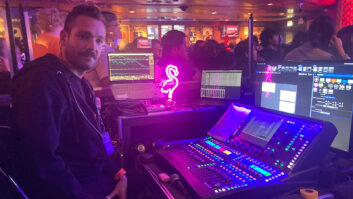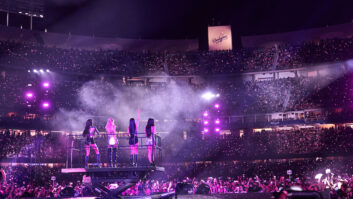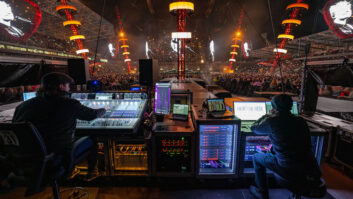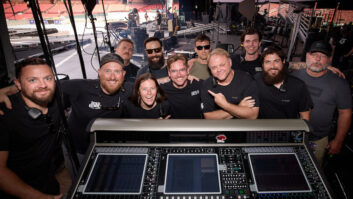New York, NY—Since the release of their fifth album, Attention Attention, in May 2018, Florida hard rock act Shinedown has been on a roll. The album debuted atop multiple Billboard charts, and the single “Get Up” pushed Foo Fighters into second place in the record books when it became Shinedown’s 11th Top 10 single on Billboard’s Rock Airplay chart. Meanwhile, the band hit the road in support of the album, sharing the bill with Five Finger Death Punch, then Godsmack, before heading out on its own tour, which is scheduled to end December 21.
Shortly before a block of about two dozen U.S. shed dates in June and July, the band called on Andy Meyer to take over the front-of-house spot. During his most recent stint with Justin Timberlake, with whom he has worked since 2005, Meyer had fine-tuned his hybrid FOH setup, integrating multiple racks of analog Rupert Neve Designs (RND) and Thermionic Culture equipment with a DiGiCo SD7 console. With only a few days’ notice before the Shinedown dates, he elected to take the same rig out again.
“I went to prep the gear and, instead of trying to break it down and rebuild it around Shinedown, I just took what I had from the Timberlake run,” says Meyer, whose résumé also includes Madonna, Guns N’ Roses, Janet Jackson and Rage Against the Machine. “These racks work—they just came off the road, they’re going back out. I’m using every bit of it and in a much different way, which has been fun.”
Related:
• Mixing Justin Timberlake on Tour, Nov. 1, 2018
• Guns N’ Roses Takes Venue to Venues, March 3, 2010

Related: Back to the Future: Josh Thomas, Rupert Neve Designs, by Kelleigh Welch, Dec. 3, 2013
Meyer started using analog outboard with Mötley Crüe, he says, around 2007, and when he rejoined Timberlake in 2012, things snowballed. The RND gear he used with Timberlake’s 16-piece band grew to include a 500 Series rack with multiple 542 Tape Emulators and 535 Diode Bridge Compressors, a Shelford channel, a 5059 Satellite Summing Mixer, a couple of RNDI boxes and Portico pieces, including a 5043 Compressor-Limiter Duo, 5014 Stereo Field Editor, 5045 Primary Source Enhancer, Portico II channel and a pair of Portico II Master Buss Processors.
“It’s good gear and it’s solid, and I found a simple way to integrate it,” he says. Cabling the rig was going to cost $26,000, Meyer reports, so he put together a system of Optocore interfaces and Apogee Symphony converters to connect the analog gear with the SD7—which has DiGiCo’s new Quantum engine and thus 32-bit preamps—using just two pieces of fiber.
“The analog gear is all on inserts. The summing is out of the console subgroups into summing mixers. That goes into the mastering rack and back into the console and is fed to the P.A.,” he says.
Production provider Clair Global supplied a Cohesion series speaker system. “It’s a CO-12 P.A. with their CP-218 subs. The CO-12 has been great on this tour. The subs are my favorite in the world, bar none.” On the next leg, he says, which switches to arenas, “We’ll be using CO-12s on the main hang and CO-10s on the side hangs, CP-218 subs and CO-6s for front fill. It’s an excellent front fill.”
Related: Ocean Way Hosts Shinedown, March 4, 2012
The band threw something of a curveball at Meyer for the summer shed leg, launching a new show during which the four band members leave the stage halfway through the set and reappear on individual satellite stages toward the rear of each venue. The configuration is being retained but modified for the coming arena leg.
“It’s difficult to get the cabling out there and get everything together every day, but you know what? It’s awesome for the crowd,” says Meyer. “You’re bringing the show to them. It’s fun to watch people’s faces.”
Nearly the first thing Meyer did to prepare, he says, was change out the vocal microphones to sE Electronics V7s. “I’m happy that they were able to deal with the change because I can open these mics up and they can talk with each other right in front of the P.A. and it’s fine. It was a little more difficult with the older microphones they were using.”
Barry Kerch’s second drum kit was set up immediately behind the FOH position, with guitarist Zach Myers and bassist Eric Bass (who co-wrote, produced and mixed the new album at his South Carolina studio) on risers to stage left and right, respectively, while vocalist Brent Smith was on a riser by the lawn. “There’s a mult that comes to front-of-house for the drum kit, so it’s old school, with mic lines and multi-cable going back to the deck. The rest of it—Brent and the guitars—is wireless. Keyboard and vocal positions for Zach and Eric are wired, but that breaks out from front-of-house, so we just have 50- or 100-footers going in either direction. No big deal,” says Meyer.
Chris Lightcap, Shinedown’s monitor engineer for the last 12 years, carries duplicate sets of Shure PSM 1000 IEM transmitters and Shure Axient Digital receivers for the vocal mics. “We put those at front-of-house; that way, when the guys are out there, we’re 150 or even 200 feet closer to the performance area. That’s all networked and controlled through Shure’s Wireless Workbench. On my walk out there, I could mute the transmitters on stage and unmute the transmitters in the house,” he says.
Lightcap mixes on a DiGiCo SD5, driving band and tech in-ears plus stereo side fills, which comprise one Clair R4 and one CP-218 per side. The SD5 is linked to two Waves servers. “A lot of it is bus compression on the outputs for everybody’s mix,” he says. Other than that, he says, he uses the typical plug-ins: “C6 multiband compressor, SSL Channel Strip, H-Verbs for vocals and drums.”
As the band and crew were trying out the satellite stage setup ahead of the first show in Texas, Kerch thought he might adopt a hybrid acoustic-electric kit to keep the level at FOH under control, but he ultimately used acoustic drums. “We put Plexiglas on three sides so the audience members don’t get bashed in the face by the snare drum,” says Meyer. “I put on headphones and time them up with the P.A. every day. When we line check during the day, I walk down to where I can hear the P.A., listen and give my system guy the thumbs-up.”
Meyer worried that the delay between the satellite drum kit and the sound from the P.A. would be distracting for the crowd. “You can’t really fix the delay, but people don’t care. There isn’t one confused look. They sing their hearts out and smile.”
Clair Global • www.clairglobal.com
Shinedown • www.shinedown.com • Facebook @Shinedown • Twitter @Shinedown
Want more stories like this? Subscribe to our newsletter and get it delivered right to your inbox.







